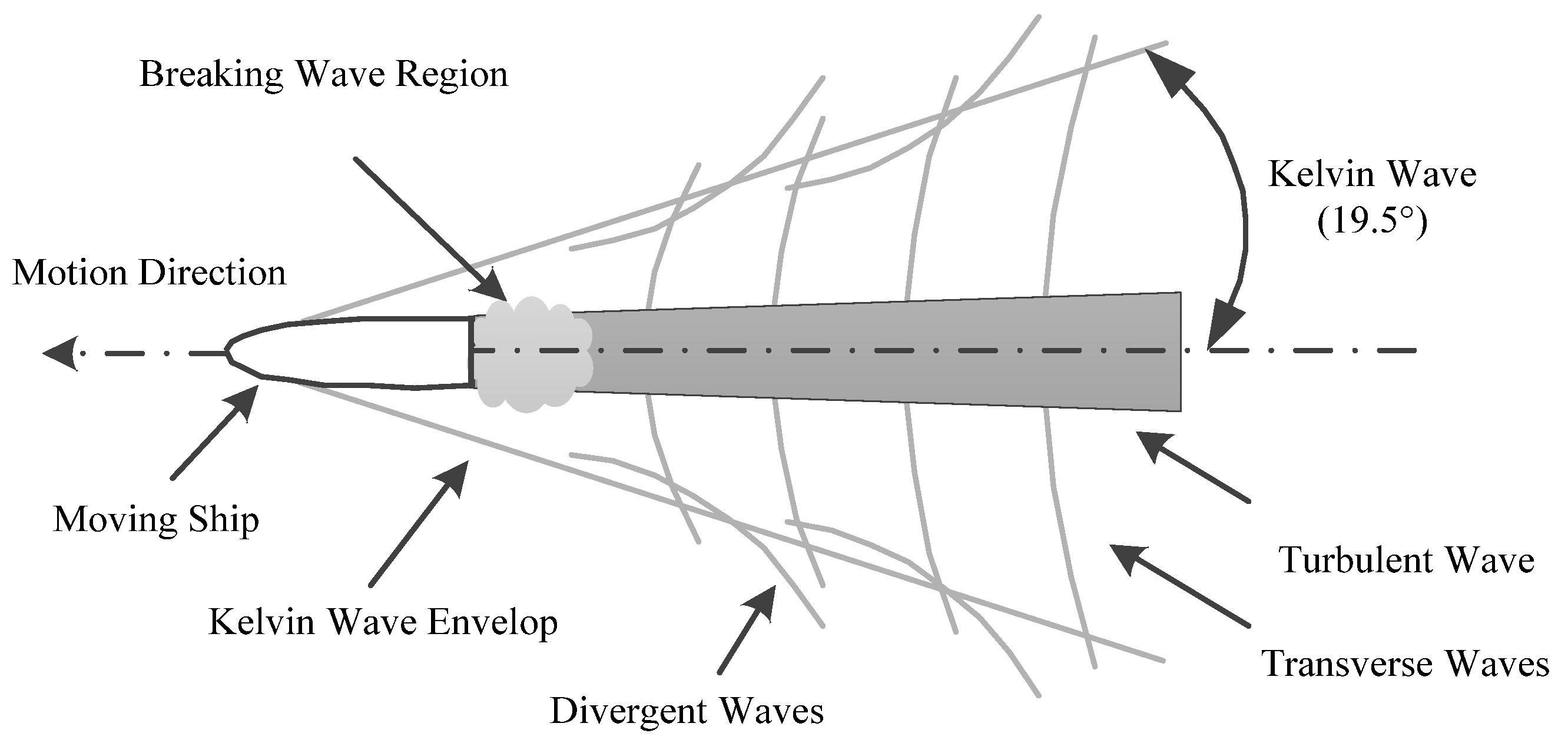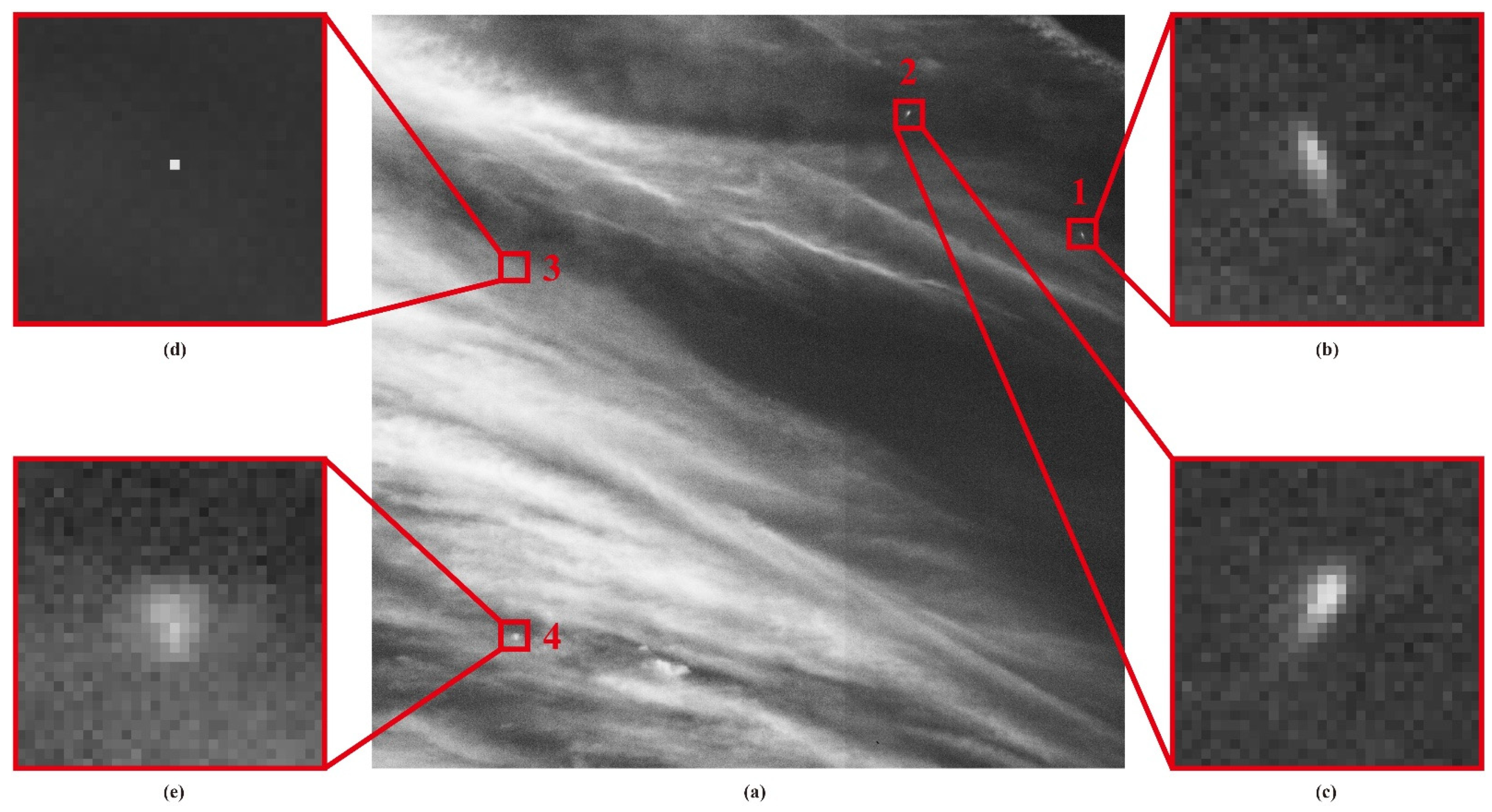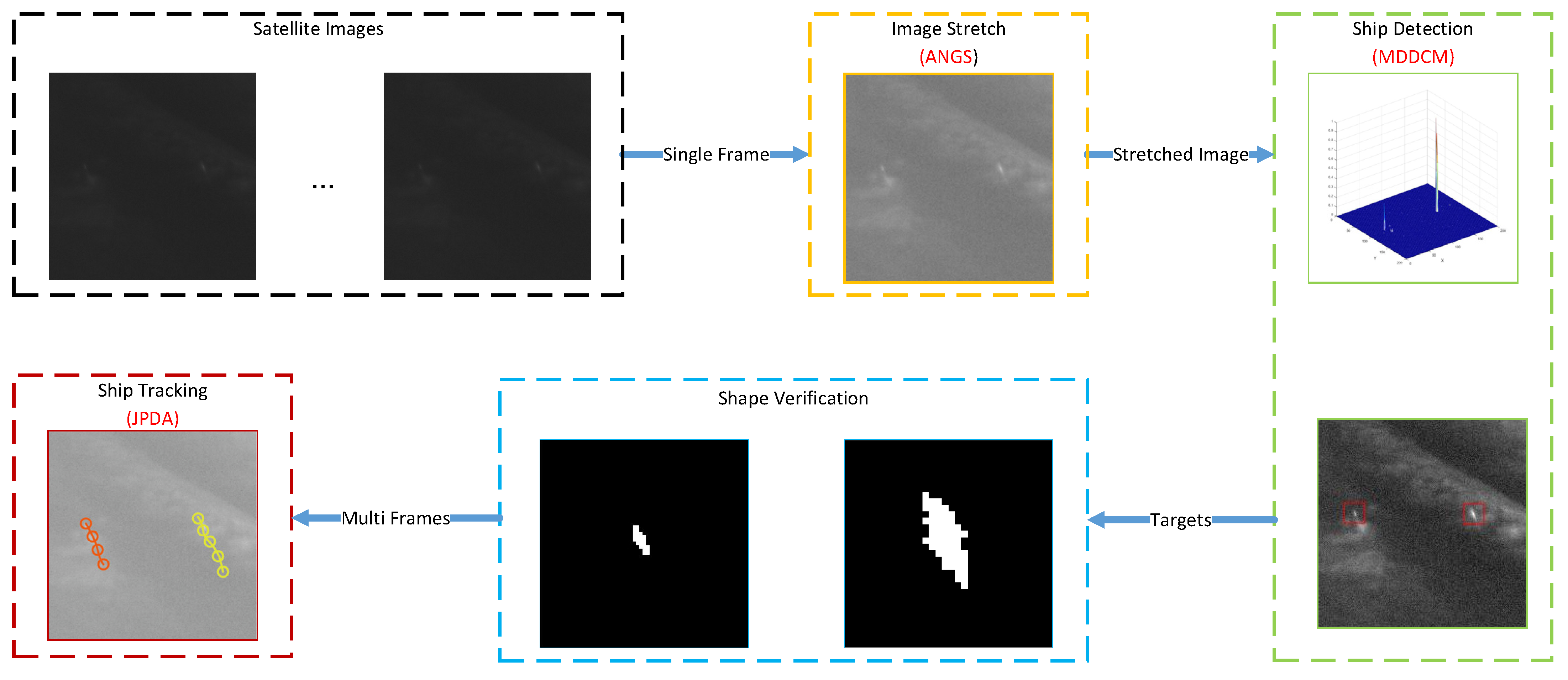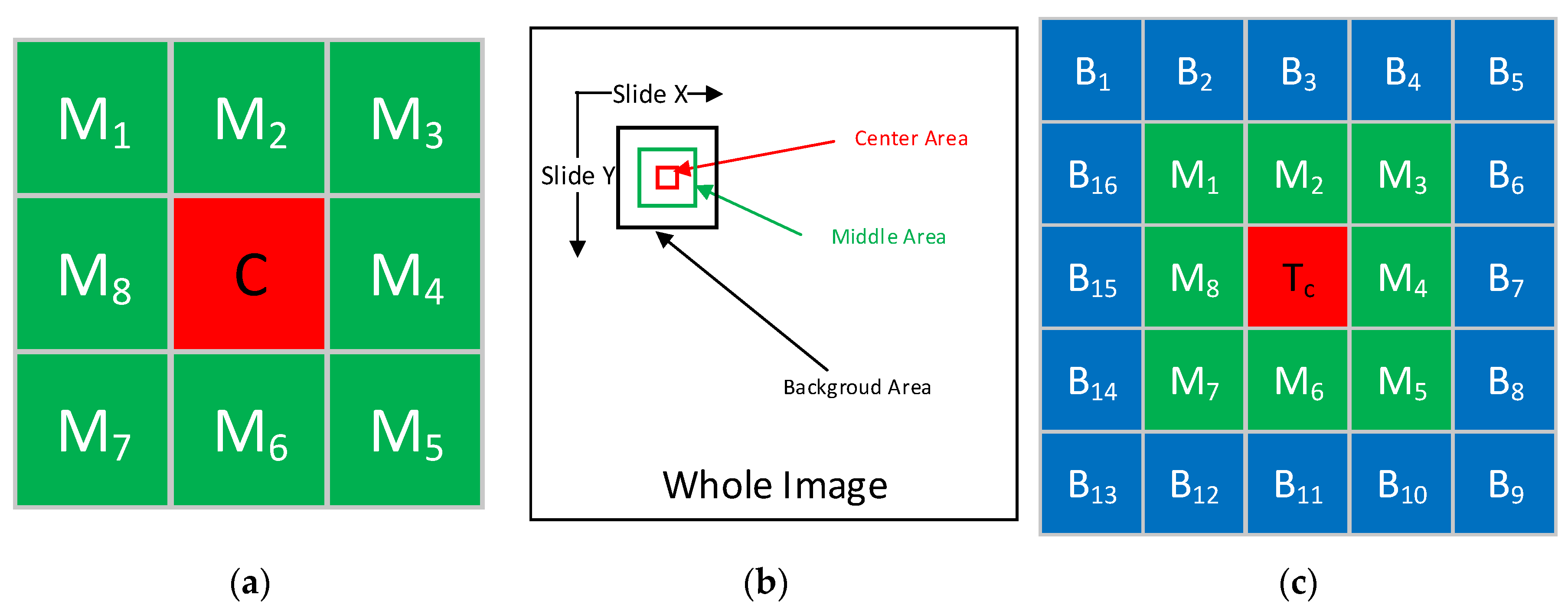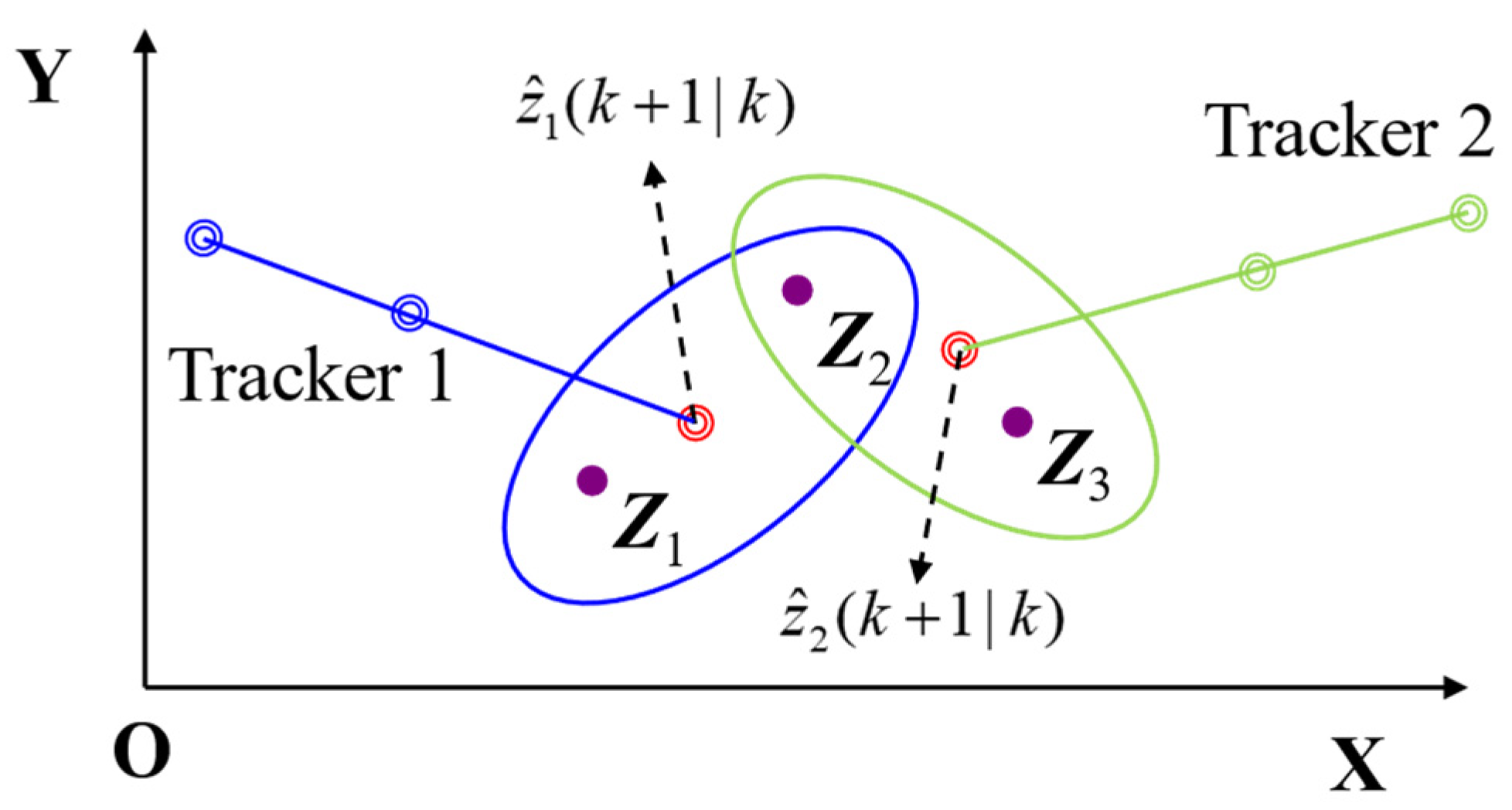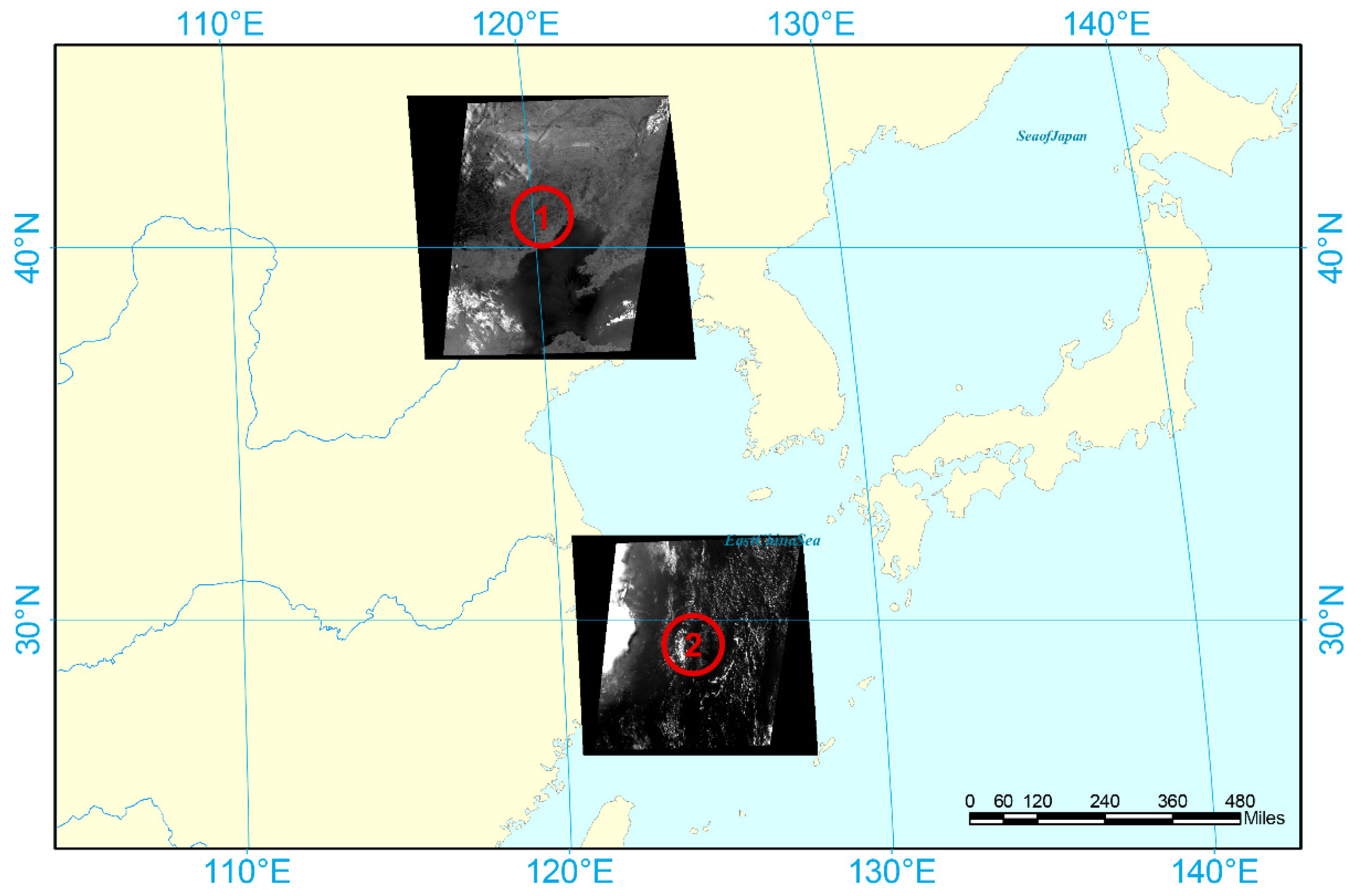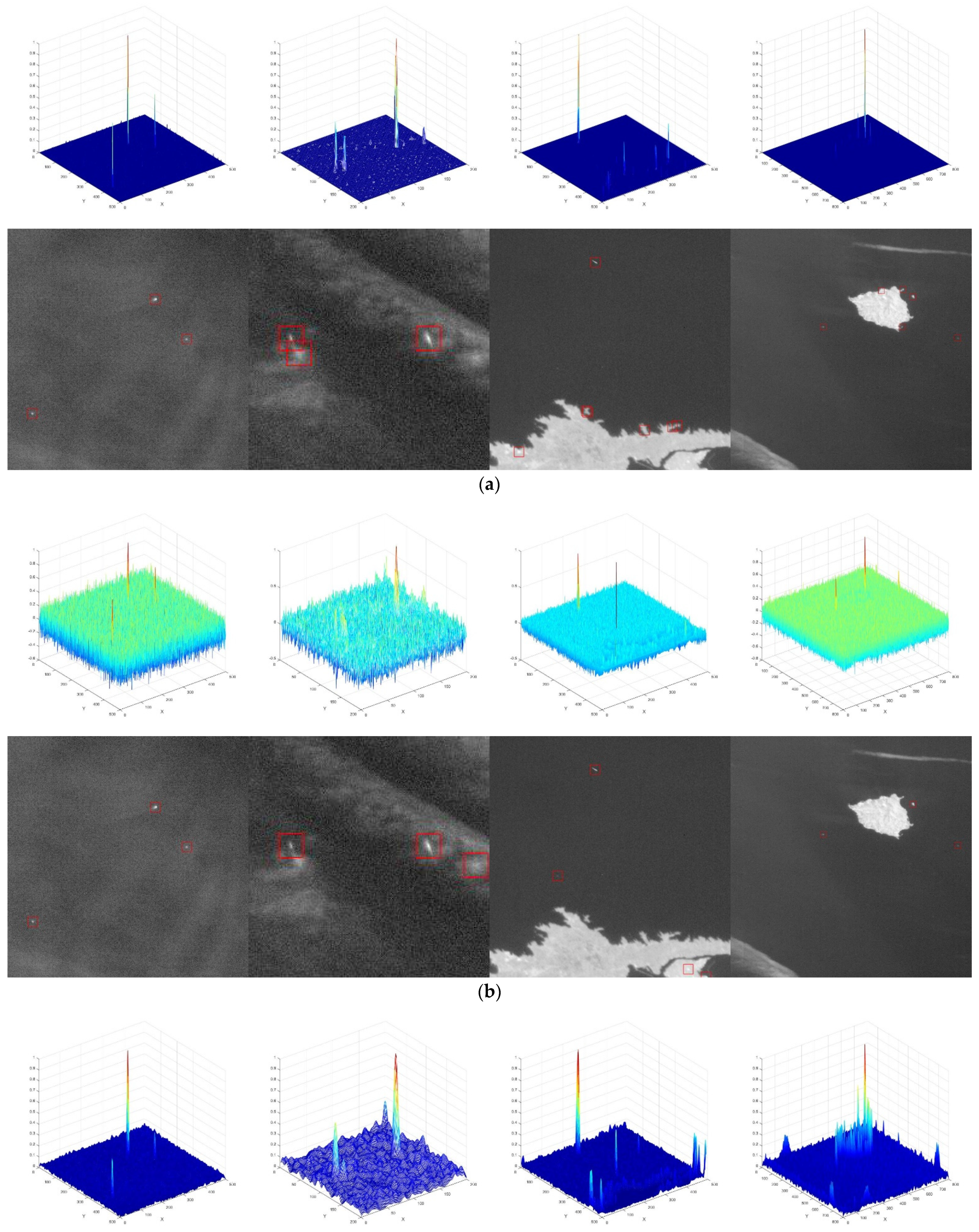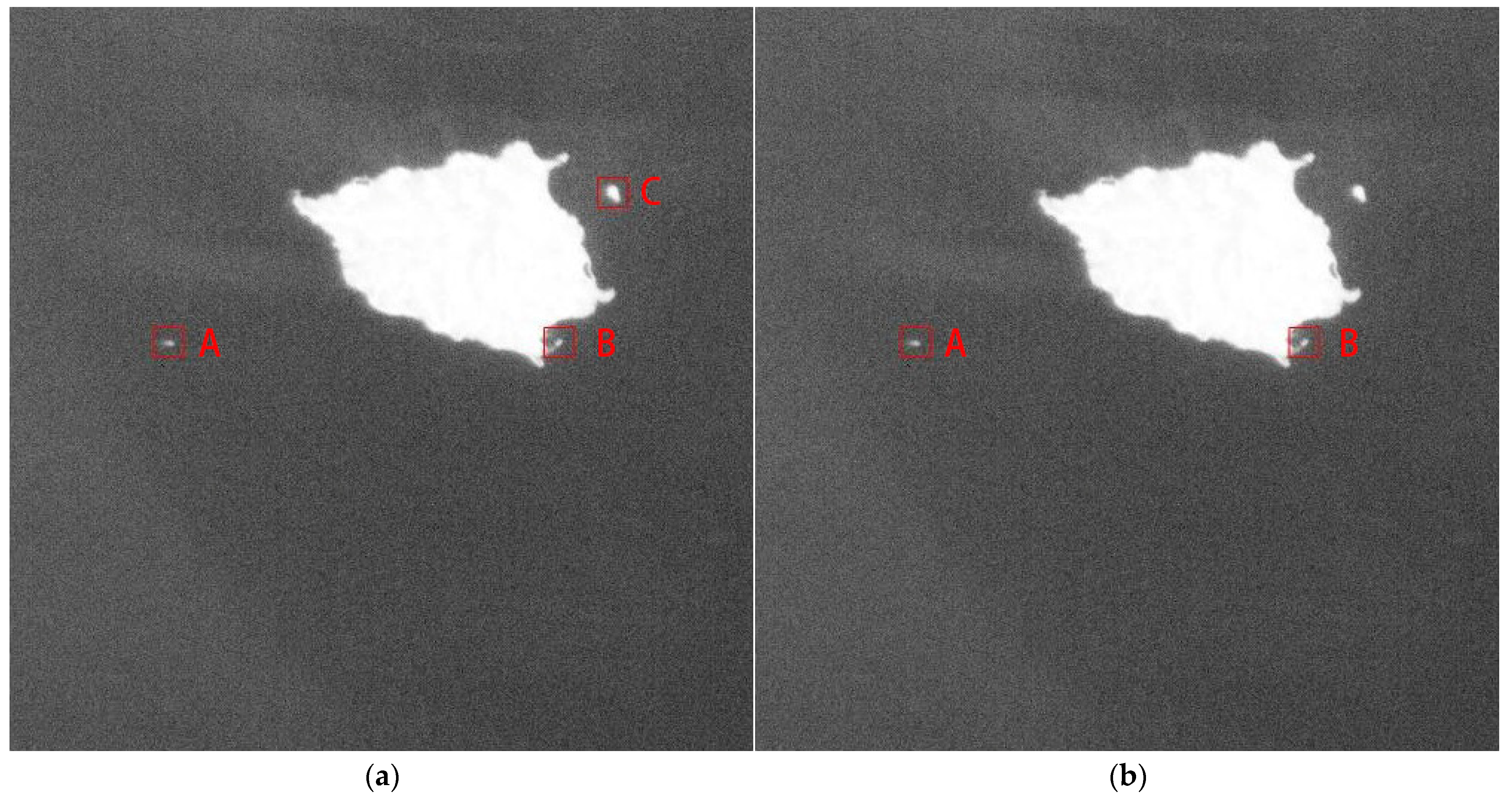1. Introduction
The surveillance of sea-surface ships is highly significant for the economic development of sea areas, marine environmental protection, marine ship management and fishery safety supervision [
1]. With the rapid development of aerospace, sensor and computer technologies, satellite remote sensing technology has also developed rapidly and has become an important means of monitoring maritime ships [
2]. For many years, synthetic aperture radar (SAR) images have been used to detect and track ships, since these images are not affected by weather or time. Compared with SAR satellite images, optical satellite remote sensing images better reflect the shape of ships, which makes them easier to recognize and interpret manually. In this respect, high-resolution optical remote sensing images from low Earth orbit (LEO) satellites have been used in recent years to detect and identify ships on the sea [
3,
4,
5,
6,
7,
8] since they provide rich information on the shape and texture of ship targets. However, LEO satellites only provide limited coverage and have a long revisit period, which means that they cannot enable the real-time and continuous monitoring of ship targets moving on the sea surface. In contrast, geostationary orbit (GEO) satellites can continuously observe a large area and have other significant advantages, such as a wide observation range and a short observation period [
9]. They can thus be used for the near real-time monitoring and tracking of maritime ships to obtain dynamic motion information, such as the position, heading, speed and trajectory of moving ships [
10]. In 2015, China launched GF-4, a medium-resolution optical remote sensing satellite, in the geostationary orbit and this has multiple observation modes, such as a gaze mode and cruise mode and it can also conduct near real-time observations of ship targets moving on the sea [
11,
12,
13,
14].
At present, the mainstream methods used to detect targets in optical remote sensing images include analyzing the gray statistical features and employing deep learning methods and methods based on visual attention mechanisms. In this respect, gray statistical feature methods [
3,
14,
15] are based on identifying the gray value of ships or their wakes, which are significantly higher than that of the sea surface. However, the accuracy of this method is limited by the existence of clouds and islands, which cause false alarms or missed detection rates. Methods based on deep learning [
16,
17,
18] extract the textural and geometric features of a target. However, the GEO optical images lack textural information about targets and the target detection method based on deep learning cannot be applied to medium- and low-resolution remote sensing images. In contrast, the method based on the visual attention mechanism [
19,
20] can quickly and accurately extract regions of interest from complex scenes and the contrast mechanism, multi-resolution representation, size adaptation and other characteristics of the human vision system (HVS) make it efficient and robust for small target detection.
The gray value of ship targets in optical remote sensing images is generally much lower than that of clouds and islands. However, owing to the long imaging distance coupled with atmospheric attenuation and cloud occlusion, it is difficult to observe the ship itself in an optical remote sensing image from a GEO satellite with a medium resolution and it is not easy to detect the ship directly. A ship forms a wake behind it as it moves and the area of the wake is always larger than the ship itself. In addition, compared with the sea surface and the hull, a ship’s wake often has stronger optical reflection characteristics and these are a main feature used to identify and detect a moving ship. Therefore, detecting and analyzing the wake of a moving ship is an effective method of detecting its movement on the sea surface. Some studies have researched ship target detection and tracking methods based on GEO optical images [
15,
21,
22,
23]. However, these methods do not consider the wake of a moving ship. In addition, cloud and island interference causes false alarms or missed detections.
Data association is another core issue limiting accurate ship tracking. Classical data association methods include nearest neighbor (NN) data association methods, various improved methods based on NN, joint probability data association (JPDA) methods [
24] and multiple hypothesis tracking (MHT) methods. One study [
21] used the MHT method to achieve multi-frame GF-4 optical satellite remote sensing image ship target-associated tracking while suppressing false alarms and another [
22] used the DCF-CSR algorithm to track ship targets in the remote sensing image of a geosynchronous orbit optical satellite. However, considering that track crossing does not occur at the same time for ships moving on the sea, calculations using the MHT method is complicated; hence, the JPDA method is more suitable for ship tracking.
In this study, we analyze the wake characteristics of ships moving on the sea and propose a moving ship detection and tracking method based on the optical remote sensing images from GEO satellites, specifically involving GF-4 satellite panchromatic remote-sensing images. First, the ANGS method is used to enhance the optical remote sensing image, with the aim of suppressing bright cloud and sea clutter in the image and highlighting the dim ship wake. Second, based on the visual saliency theory, we propose a multiscale dual-neighbor difference contrast measure (MDDCM) method, which calculates the saliency map of the image and obtains the location of the salient target. The wake shapes of moving ship targets are analyzed and false targets (such as speckle clouds) are removed from the candidate targets via verifying the shape of the ship’s wake. Finally, the JPDA method is used to conduct data association and multi-target tracking in multi-frame images, with the aim of obtaining the speed and track of real moving ship targets and false targets, such as stationary islands, are also removed.
The following sections provide the following information: in
Section 2, we analyze the imaging characteristics of a GF-4 image and the wake characteristics of the moving ship in the image;
Section 3 describes the methods proposed in this paper in detail, including the image enhancement method, target detection method and data association method employed;
Section 4 presents the experimental results and an analysis of the proposed method; the conclusions are provided in
Section 5.
2. Analysis of Wake Feature in GF-4 Satellite Optical Remote Sensing Images
GF-4 has a high temporal resolution, a wide coverage and multiple imaging bands. The camera parameters of GF-4 are list in
Table 1.
GF-4 images have a spatial resolution of 50 m in the visible band; therefore, a ship that is several hundred meters in length and tens of meters in width occupies only a few pixels in the GF-4 image. In addition, some hulls are coated in stealth materials and lack reflective features, which makes it difficult to detect them directly. Therefore, the characteristics of a ship’s wake are analyzed in this study with the aim of effectively detecting the presence of a ship.
The wake of a ship is mainly caused by the force between the hull (propeller) and the sea when the ship moves on the sea; this causes subsurface sea water to rise to the surface, which forms the wake. Normally, the width and length of the wake are approximately 1–3 times the width of the ship and 1–20 times the length of the ship, respectively. The wake of a moving ship mainly comprises Kelvin, divergent, transverse, turbulent and breaking waves, as shown in
Figure 1. Different wave types of the wake can be identified in different image types. For example, in SAR remote sensing images, Kelvin waves, divergent waves, shear waves and broken waves can be observed; Kelvin waves, divergent waves, shear waves, turbulent waves and broken waves can be observed in high-resolution optical remote sensing images; but only turbulent waves can be observed in GF-4 satellite optical remote sensing images. The observed wake of the turbulent wave appears as a spindle-shaped bright area in the GF-4 image and its brightness and width decrease continuously along the opposite direction of the ship’s motion. The main factors affecting the turbulence wake size in the GF-4 images are the size and sailing speed of the ship.
Figure 2a shows a two-dimensional (2D) view of the original GF-4 image,
Figure 2b shows a 2D view of the stretched GF-4 image and
Figure 2c shows a three-dimensional (3D) view of
Figure 2a. It is evident that extremely bright flawed pixels appear at (245,448) and dark flawed pixels appear at (672,966). Therefore, it can be concluded that in the GF-4 images, the maximum and minimum gray values are often represented by flawed pixels. In addition, the gray value difference between the clouds and the sea is not obvious and the gray value change is mainly reflected in the floating change in cloud brightness. Furthermore, the ship’s wake is difficult to find.
Figure 2b shows a 3D view of the stretched GF-4 image, where the gray difference between the cloud and sea background has been enlarged, the flawed pixels at (245,448) and (672,966) have been suppressed and the ship wakes at (713,131) and (944,291) have been highlighted. This is therefore a better image to use for detecting the ship’s wake.
GF-4 satellite optical remote sensing images can contain cloud clutter, ships’ wakes and flaws, as shown in
Figure 3. After analyzing this image, the following were determined: (1) GF-4 satellite optical remote sensing image contain a large number of bright clouds and the gray values of these are higher than that of the ship’s wake; (2) the ship forms an obvious wake as it moves on the sea and the gray values of the wake are higher than the sea background; (3) the wakes of different ships differ in size and brightness in relation to the size and speed of the ship itself; and (4) flawed image pixels from the camera of the GF-4 satellite result from the very harsh electromagnetic radiation environment of the stationary orbit. The remote sensing image contains several bright and black flawed pixels, but there are more pixels representing the ship’s wake than there are flawed pixels; (5) the brightness of the cloud varies, but there are large areas of bright clouds or local bright spot-shaped clouds.
3. The Proposed Methods
The above analysis shows that identifying ship targets in GF-4 satellite optical remote sensing images is problematic due to clouds and flaws. However, the brightness of the ship’s wake is lower than that of clouds but higher than that of sea background and image stretching can enhance the ship’s wake within an image. Although the ship’s wake in the image is a turbulent wake with a certain shape, it remains weak and only occupies a small number of pixels within the image. However, as the GF-4 satellite is a video-like satellite that can continuously scan the observation area and form an image sequence, the multi-frame association method can be used to identify a moving ship and remove false targets. The target detection and tracking framework of sea-surface moving ships proposed in this study are shown in
Figure 4.
The method proposed in this paper includes four stages: image enhancement, ship detection, shape verification and multi-frame association and are outlined as follows:
- (1)
Image enhancement stage: ANGS is used to enhance each frame of the GF-4 image sequence to improve the image contrast and highlight the ship’s wake in the image.
- (2)
Target detection stage: the focus of this study is to detect targets based on visual saliency. In this respect, the MDDCM method is used to calculate the saliency map and the image is then segmented according to the dynamic threshold value to obtain the location of the candidate ship target.
- (3)
Shape verification stage: based on the detection results of MDDCM, the region in which the target is located is binarized to obtain the shape of the ship’s wake and remove false targets that do not have ship wake characteristics.
- (4)
Multi-frame tracking stage: the JPDA method is used for data association to confirm the real moving ship target from the candidate targets in multi-frame images. In addition, the ship’s speed and its track are obtained and false targets, such as stationary islands, are removed.
3.1. GF-4 Satellite Optical Remote Sensing Image Enhancement
The analysis above showed that the pixels with the greatest brightness in the GF-4 satellite optical remote sensing image are often flawed and the brightness of cloud is generally higher than that of the ship’s wake. Therefore, to effectively detect ships on the sea surface, it is necessary to enhance the GF-4 image to heighten the contrast between the ship’s wake and the sea background. Image enhancement methods are generally divided into spatial domain enhancement and frequency-domain enhancement methods. However, owing to the uncertain size and shape of a ship’s wake, the frequency-domain enhancement method is not suitable for image enhancement in this context. Therefore, spatial domain image enhancement methods are preferred and these include histogram equalization, Laplace transform, log transform and gamma transform. In this paper, an adaptive nonlinear gray stretch (ANGS) method is used to suppress high-brightness clouds and to simultaneously enhance the brightness of the ship’s wake. The formula for the ANGS is as follows:
where
G (
x,
y) is the original remote sensing image of GF-4,
is the mean value of the original image
G (
x,
y),
E is the stretch factor that controls the slope of the stretch curve and
eps is a very small value that prevents the formula from being meaningless when
G (
x,
y) = 0. Furthermore,
E is an empirical value and different stretching factors of
E have different stretching effects on the image: the larger the value of
E, the greater the gray contrast near the mean value
and the gray value compression of the high and low gray levels is also stronger.
3.2. MDDCM Method for Ship Wake Detection
As previously mentioned, the analysis conducted in
Section 2 showed that the gray value of the ship’s wake in the GF-4 image was lower than that of the clouds and the land. A ship’s wake generally occupies only a dozen (or sometimes a few) pixels in a GF-4 image and, thus, it is a small and dim target. In recent years, algorithms based on the human visual system (HSV) have demonstrated a good performance for detecting dim and small targets. HVS algorithms, including the local contrast measure (LCM) method [
25] and multiscale patch-based contrast measure (MPCM) method [
26], generally use the local gray difference between the target and the surrounding background to calculate the contrast and extract the target position. Based on the HVS theory, we propose a multiscale dual-neighbor difference contrast measure (MDDCM) method for detecting a ship’s wake in GF-4 images.
3.2.1. DDCM Window Structure
The traditional LCM window is shown in
Figure 5a. The window includes nine sub-blocks: a central block and the adjacent eight sub-blocks. The traditional LCM algorithm measures the visual salience of the central block by calculating the contrast between the central block and the surrounding eight sub-blocks.
In contrast to the traditional LCM window, we designed a dual-neighborhood window that includes central, middle and background regions. By sliding the dual-neighborhood window onto the entire image, the local contrast of the image can be calculated and a saliency map is then generated. The sliding process is illustrated in
Figure 5b. The structure of the dual-neighborhood window is shown in
Figure 5c, which contains a central region R
C, middle region, R
M and background region, R
B. R
C contains 1 sub-block, T
c, R
M contains eight middle sub-blocks, M1–M8 and R
B contains 16 background sub-blocks, B1–B16.
3.2.2. DDCM Local Contrast Calculation
Our previous analysis showed that a ship’s wake appears as a spindle-shaped bright area in a GF-4 image. When the wake is small, it appears as a Gaussian spot and when the wake is large, it appears as a long strip. The distribution of the Gaussian spot-like ship’s wake on the DDCM window is shown in
Figure 6a. As the course of the hull is arbitrary, we use four angles, as shown in
Figure 6b–e, to roughly describe the distribution of the strip-like ship’s wake in the DDCM window.
Based on the DDCM window structure, the difference between the three regions is used to measure the local contrast. The contrast between the central sub-block, T
c and the middle region of each sub-block,
, is represented by
and the expression of
is
where
represents the gray mean of the central sub-block, T
c;
represents the gray mean of the middle sub-block,
; and
i = 1, 2, 3...... 8.
The contrast between the central sub-block, T
c and the background region is represented by
and the expression of
is
where
represents the gray mean of the central sub-block, T
c;
represents the gray mean of the background sub-block
, where
k = 1, 2, 3... 16; and
represents the maximum value of
in 16 background subblocks. The gray value of the central region where the ship wake is located is generally higher than that of the outer background region; therefore, by identifying
, cloud clutter can be effectively suppressed and the ship’s wake can be highlighted.
A ship’s wake is generally distributed symmetrically along the central axis. When the central sub-block of the DDCM window passes through the center of the ship’s wake, a part of the ship’s wake may be distributed in the middle region. Therefore, the contrast between the central region, R
C and the middle region, R
M, can be expressed as
, where the expression of
is as follows,
where
represents the maximum value of
for the middle region of eight sub-blocks and the sub-block corresponding to
may be the sub-block where the ship’s wake symmetry axis is located. Therefore, we use the sub-block perpendicular to the sub-block of
to calculate the contrast between the central region, R
C and the middle region, R
M.
If the size of the central region, R
C, in the DDCM window is
k ×
k, the visual saliency of the
k-size DDCM can be expressed by
as follows:
where
is the contrast between the central and middle regions and
is the contrast between the central region and the background region. By setting the value of the DDCM window size
k and using the DDCM window to slide through the entire GF-4 image, a single-scale DDCM saliency map is obtained.
3.2.3. MDDCM Local Contrast Calculation
The size of a ship’s wake varies in accordance with factors such as the hull size, sailing speed and the spatial resolution of the image that it is caught within. Therefore, a single-scale DDCM window is not suitable for detecting ships’ wakes of all sizes. We thus use the multiscale dual-neighbor difference contrast measure (MDDCM) method to detect the wake of a ship.
The DDCM saliency map of size k can be represented as
; the saliency of a pixel
in the image can be represented as
; and the expression of the saliency
of pixel
in the MDDCM algorithm is as follows:
where
k is the size of the DDCM and the minimum and maximum values are 2 and K, respectively. Therefore, the MDDCM with the largest scale of K can be expressed as
3.2.4. Adaptive Extraction of Ship’s Position Based on MDDCM
Following the MDDCM calculation, an MDDCM saliency map of the image can be obtained. The contrast of the area of the ship’s wake is enhanced, while bright flaws, random noise, cloud clutter and sea background clutter are effectively suppressed and the signal-to-noise ratio (SNR) is significantly improved. To extract the target, we normalize the saliency map to distribute it between 0 and 1 and then use an adaptive threshold to segment the saliency map to obtain the location of the target. The expression of threshold τ used for saliency map segmentation in this study is
where
μ is the mean value of the MDDCM saliency map, σ is the standard deviation of the MDDCM saliency map and
is the segmentation factor, which typically ranges from 20 to 50. Using the threshold τ to segment the saliency map, the position of the target, (the candidate ship) is extracted.
3.3. Shape-Based False Alarm Removal
The detection result of the MDDCM saliency map provides the position of the candidate ship in the image, but they do not show the size and shape of the candidate ship. In fact, the extraction result in the MDDCM saliency map is usually the central position of the ship’s wake. Therefore, after obtaining the location of the ship using MDDCM, it is necessary to segment the target candidate region to contour information about the candidate ship. Shape verification can then be used to remove false targets, such as spot-shaped clouds.
Based on the location of the candidate target extracted by MDDCM, we extracted 64 × 64-pixel regions of interest (ROI) and then used the Otsu method to perform binary segmentation of the ROI to separate the target from the sea surface background. The formula is as follows:
where
is the segmentation threshold of Otsu’s method. For the segmented image, the connected region centered on the detection result of the MDDCM saliency map is the region of the ship. However, the detection results of the MDDCM saliency map often contain false alarms, but through binary segmentation of the target area, the target contour can be obtained and the target’s shape characteristics can then be verified.
The spatial resolution of the GF-4 satellite optical remote sensing image is 50 m and the width of a ship is generally within 50 m (not exceed 100 m). According to the above analysis, the width of the ship’s wake is approximately one to three times that of the hull and the wake’s length is one to twenty times the length of the hull. Therefore, the width of the ship’s wake in the GF-4 image occupies only a few pixels but its length can be dozens of pixels. Generally, the larger the wake’s width, the larger the size of the ship or the faster its speed; this means that the turbulent wake formed behind the ship will be longer and there is thus a positive correlation between the length and width of the ship’s wake. Based on this feature, we can verify the shape of targets and remove false alarm targets that do not meet the shape characteristics of the wake. If the length of the smallest enclosing ellipse of the target area is
and the width is
, the length-to-width ratio is represented by
. Therefore, the width
and length-to-width ratio
of the wake of the ship should have a certain range. We use the following formula to verify the shape of the ship’s wake as follows:
where
and
are the minimum and maximum value ranges of the wake widths, respectively. Limiting the value of
can remove small false targets, such as flaws and large false targets, such as clouds and islands.
is the adaptive threshold value associated with
. False targets that do not meet wake characteristics can be removed using
.
3.4. Ship Tracking Based on JDPA
GEO satellites can detect and track marine moving ships to obtain their moving tracks and estimate their movement trends. In addition, data association can be used to remove false alarm targets, such as stationary islands, irregular clouds and random noise.
As previously mentioned, JPDA is a classic data association method [
24]. The main idea is to comprehensively consider all the targets and measurements, according to the association between all measurements and all targets.
In the JPDA method, the predicted state equation of the target is defined as
where
represents the state vector of
at time
predicted by time
and
is the state transition matrix of
at time
.
The prediction vector of measurement target is defined as
where
represents the measurement target matrix.
According to the Kalman filter formula, the equation for calculating the status update is as follows,
where
represents the Kalman gain matrix of
at time
and
represents the combined information of
at time
.
The associated area is defined as
where
represents the innovation covariance matrix at time
and γ is a fixed threshold that can be obtained from the
distribution table.
As an extension and optimization of the probability data association (PDA) method, the JPDA method mainly introduces the concept of joint events within the association cycle,
where
is the joint-associated event,
is the time,
is the
th joint event at time
,
represents the total number of measured targets at time
and
represents the event when the measured target,
, is related to track
at time
in the joint event of
. When
, there are no related events for the measured target,
and this indicates a false alarm.
Figure 7 illustrates the implementation process of JPDA, which first establishes a confirmation matrix and lists all possible events based on the criterion that the target provides a maximum of one piece of measurement information in a period; the measurement has only one source. Finally, all events are connected via probability to obtain the final status update value for each target.
The JPDA algorithm uses the measurement in the current scan period within the tracking threshold to calculate the correlation probability between the measurement and the corresponding track. The calculation determines the set of all possible “measurement-track” combinations and the probability of the associated set.
We use the target location extracted using the MDDCM method as the data source for data association (the shape has been verified). The JDPA is then used to associate the target data in the multi-frame GF-4 image with the aim of obtaining tracking information about the ship target and calculating its average speed. As the candidate targets in the GF-4 satellite image sequences often contain false targets, we use constraints (such as the minimum associated frames, maximum target speed, minimum target speed and minimum moving distance) to further remove false targets and filter the displacement of the stationary targets caused by camera shake.
5. Conclusions
Geostationary optical remote sensing satellites can provide continuous observations of fixed areas. The GF-4 satellite has the advantages of a high temporal resolution and large coverage, which enables continuous observation of ships moving on the sea surface. However, owing to the spatial resolution of the image, as well as interference from high-brightness clouds, islands and sea clutter, ship targets are dim and small in the image, which makes it very difficult to directly detect ships.
We analyzed the wake of a moving ship and proposed a moving ship detection and tracking method based on visual salience. Four groups of GF-4 panchromatic remote sensing images of different scenes and four groups of real GF-4 panchromatic remote sensing images were used in this study. The four groups of data included a cloudless scene, a scene containing dense cloud, a scene containing islands and a complex scene containing both clouds and islands
Through experimental analysis and comparisons with other methods, the proposed method provides a good detection performance, which has a higher recall rate of 93.1% and a lower false alarm rate of 1.9%. Thus, it can be used to effectively detect and track moving ships on the sea surface in GEO optical remote sensing satellite images, even in the presence of dense clouds and islands. Nevertheless, our method has limitations. In the presence of numerous moving spot-shaped clouds, the detection performance will sharply decline, resulting in high false alarm.
Finally, we analyzed the general influencing factors on ship detection in optical remote sensing images, such as clouds and islands and proposed an MDDCM method suitable for small target detection. In low and medium resolution optical satellite remote sensing images, ship targets are usually small and generally affected by bright clouds and islands. Therefore, we will apply the proposed method to other medium-resolution and low-resolution optical satellite remote sensing images for further research.
